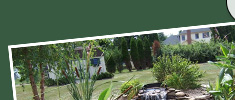
 |
Pond Information | Pond Algae | How to Choose Pond Fish | Spring Start Up Guide | Intro to Pond Plants | Seasonal Requirements | Beneficial Bacteria | Garden Pond Water Quality | Pond UVC Lights Koi and Garden Pond Water Quality
A backyard pond or water garden is a little world and eco-system we created that may need our help occasionally to achieve the natural balance necessary to sustain pond life and healthy pond fish. This is usually not difficult.
It is very important to eliminate chlorine when filling the pond. Many products are available to accomplish this. Pond fish cannot live in Chlorinated Water. A pond filter is usually necessary if pond fish are present in the garden pond. A pond filter's main purpose is to keep the pond fish healthy by establishing a beneficial bacterial colony that converts fish waste into harmless water components. It is important not to clean the pond filter with chlorinated tap water because the chlorine will kill the beneficial bacteria.
Nitrite and Ammonia levels need to be tested regularly, especially in a new pond. It may take a few weeks for beneficial bacteria to establish a colony large enough to handle the waste produced by the pond fish. It is usually advisable to add bacteria to a new pond, and every spring to established garden ponds. Start out slowly when adding fish to a new pond, so the fish waste does not overwhelm the bacteria colony. Do not feed the pond fish the first few days in the new pond, so the waste produced is kept to a minimum.
Once the pond is established it is usually sufficient to test in early spring and every few weeks after that. The pond will generally take care of itself once the natural balance has been achieved by adding bacteria and pond plants, unless substantial water changes are made.
Pond Information | Pond Algae | How to Choose Pond Fish | Spring Start Up Guide | Intro to Pond Plants | Seasonal Requirements | Beneficial Bacteria | Garden Pond Water Quality | Pond UVC Lights |
 |
||||||
 |
 |
|||||||
